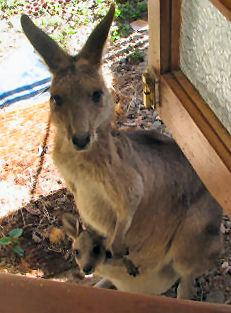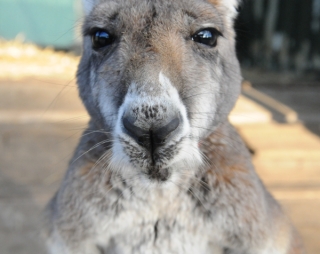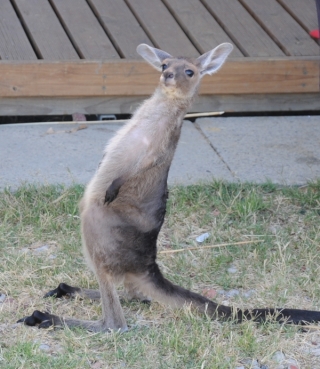A question to any West Australian readers: Which kangaroo was most commonly targeted by hunters in the mid to late 1920's? ... Well I'm being a bit unfair, the answer isn't a kangaroo at all as the answer is the western brush (or black gloved) wallaby. Around that period western brush wallaby skins were exported in higher numbers than red kangaroo or western grey skins. Which species is exploited most commonly these days? Well I can tell you it isn't the western brush wallaby, they are now listed as near-vulnerable. To the vast majority of Australians living in large cities the answer doesn't seem to matter anyway, the generic term "kangaroo" is often used when discussing anything macropod related. Kangaroo numbers being in "plague proportions" or the labelling of them as pests appears to apply to all of our larger marsupials.
Attempts to overcome Australians' reluctance to eat kangaroo meat
Over the last ten years or so the kangaroo industry, state and federal governments and organisations such as the FATE program have tried to shift public perception of the kangaroo image from pest to sustainable resource. They appear to have had very limited success. In doing this they have continued the tradition of grouping all of the exploited species under the kangaroo banner. Australians have been very reluctant to come to the party when it comes to eating kangaroos themselves, maybe it's got something to do with us viewing roo meat as something that is only fit for the dog. So what is the dog actually eating? Is it euro chunks? Diced eastern grey? Maybe minced Bennetts wallaby? The marketing of kangaroo meat for human consumption continues this trend. Why do you think that could be? Maybe it is easier for us to stomach roo meat when we don't have to put a face to it ... a sort of miscellaneous meat. Nevertheless a lot of us are still reluctant to dine on our national symbol. Overseas markets for kangaroo meat are notoriously unstable, for example : the Russian ban on roo meat imports last year, this may however be offset by the recent Chinese decision in favour of the kangaroo industry.
Eating kangaroo compatible with vegetarianism?
Of course there are many Australians who choose to be vegetarian/vegan. Often this choice of lifestyle is made based on several factors including personal health, animal welfare or viewing this diet as being more ecologically sustainable particularly in a warming climate. I would have thought that once an individual had made the choice to stop eating meat that right should be respected, it's not the choice for everybody but with the earth population rapidly approaching 7 billion people surely vegetarianism is not something we should discourage. To those involved in promoting the human consumption of kangaroo however, vegetarians represent a potential market. This was evident in the publication of an article in the Sydney Morning Herald last week when the term "kangatarian" was coined. The basic message is that vegetarians with animal welfare or environmental concerns should find kangaroo meat quite acceptable. This is due to the fact that kangaroos are killed humanely in the field and their presence on the Australian landscape ticks all the right environmental boxes. Surely this advertisement is the work of the Australian kangaroo industry, who else would recklessly attempt to add roo meat to the diet of a vegetarian? Well the university lecturer in this advertorial is Peter Ampt, the manager of the Future of Australia's Threatened Ecosystems program (FATE). The FATE program was the initiative of Professor Mike Archer whose book "Going Native" (now out-of-print) outlined the programs aims. Central to these aims was the phasing out of current agricultural/pastoral practices in favour of those utilising native animals and plants. The centrepiece (or stumbling block) for the program is the sustainable harvesting of kangaroos. Backing up Peter Ampt's claims is Sarah Doornbos, who is also involved in the FATE program though no mention is made of this.
The evidence contradicts claims of humane killing
It seems that a key part of their argument revolves around the humane killing of kangaroos as opposed to traditional livestock. This same tactic comes up again and again, a single bullet to the head is a clean, humane way of killing an animal. No argument there assuming that is always the case, the problem is that it's not that simple. Female kangaroos have joeys and those joeys depend on them for survival. The Code of practice for the humane shooting of kangaroos (or "the code") instructs kangaroo shooters to kill in-pouch joeys by crushing their skull or decapitation. In the field this equates to smashing their head against an object such as a towbar or just simply stomping on their skull. It is not only in-pouch joeys that are dependent on their mothers. For about a third of the time you can call a kangaroo a "joey" they have permanently exited the pouch, however they still require milk, protection and guidance from their mother. These little guys are the joeys-at-foot or ex-pouch joeys, they are the ones that stick their heads in their mother's pouch to obtain milk. This a key stage in the development of a kangaroo that usually lasts 120 – 220 days. The code directs shooters to kill these joeys by a single shot to the head, however these joeys tend to flee in terror when their mothers are shot. As kangaroos do not "adopt" other joeys in the wild their prospects for survival are very poor, most will likely starve to death or be taken by predators. How this can be classified as humane by Samantha Vine, Peter Ampt and Sarah Doornpos is to say the least, puzzling. I shudder to think what would come under the inhumane category, perhaps death by iron maiden?
Official Statistics
Of course the industry itself will counter this argument by claiming 80% of kangaroos shot are males. State kangaroo management data does not substantiate this figure. For example in New South Wales the long term average is 66.9%, in Queensland the figure appears to be somewhere in the mid 70's and in Western Australia the figure is close to 50%. There have even been years in WA when the figure has dropped as low as 47% such as 1993.
Scientific Debate?
The timing of this advertorial coincides with the proposed European Union ban on kangaroo product imports. John Kelly, the executive director of the Australian Kangaroo Industry has been busy defending the industry using claims such as the one mentioned above. He declares that this issue will ultimately be decided using scientific arguments. It is interesting that this scientific approach consists of misleading statistics and an online petition supporting the kangaroo harvest, John Kelly is the number one signatory and who is the organiser ... ? Professor Michael Archer.

The fate of a joey-at-foot also applies when its mother has been killed in a vehicle collision. A small joey may be observed returning to its mother several times on the roadside after her death. It makes for a very distressing scene, the joey will ususally attempt to wake the mother up by touching her and/or making sounds and may attempt to enter the pouch. If the mother had fallen victim to a kangaroo shooter, all that could be left behind are her head, forelimbs, tail, entrails, a discarded in-pouch joey and a lot of blood. Of course the skin-only shooter will leave behind the entire body ... minus skin of course ... what becomes of the dependant joey-at-foot returning to its mother now? This type of treatment would be unacceptable in the domestic livestock industry, how can anyone possibly classify the shooting of kangaroos as humane? In WA alone 30,000 joeys-at-foot were orphaned by the actions of commercial kangaroo shooters in 2007, that's about 80 joeys every night of the year. West Australian kangaroo kill figures are dwarfed by states such as Queensland where shooters killed over one and a half million kangaroos in the same year. It's very convenient for FATE or the kangaroo industry to withhold this information from those trying to make an informed decision on roo meat. The inhumane treatment of joeys occurs at night and often in very remote areas, visual footage is a rare thing. It's a shame that people such as those interviewed in this advertorial believe their agenda trumps any concerns about the kangaroo industry. Maybe it's just easier to misrepresent the truth when you're picking joey bones from your teeth.



Comments
Tigerquoll
Wed, 2010-02-17 10:33
Permalink
Joey delicacy & the head shot farce
Good review Scott.
I am half surprised that the poachers don't try to flog joey meat as a delicacy in the same vane as quail.
Roo poachers couldn't tell the difference between kangaroos species, let alone between a male and female kangaroo. I challenge all roo shooters to sit an exam to distinguish between macropod species and sexes before having their permits shooting renewed.
Few people would know let alone could distinguish between a Bridled Nail-tailed Wallaby (near extinction), Brush-tailed rock wallaby (critically endangered), a Swamp Wallaby and a Sand (Agile) Wallaby.
As for the regulated head shot requirement, I doubt few poachers would have marksmanship to shoot a kangaroo in the head at 200m, which is about as close as one could get without spooking them.
Even then, the light would be poor (when they are grazing at dawn or dusk or night) and the type of rifle and scope needed to guarrantee a headshot at that distance in that light would be prohibitively expensive.
Australian hunters tend to use the .222 or the .243 centre fire hunting rifle, which has an effective range with scope of up to 100m if a shooter has excellent vision. Beyond that one is looking at a more powerful .308 or 7.62 calibre rifle which cost over $3000 with high resolution scope. Few roo poachers would have such a weapon.
So the reality of the mandatory 'point of aim' being a head shot is a farce. The relevant law, the National code of practice (commercial and non-commercial) for the humane shooting of kangaroos and wallabies (Schedule 2) is ineffectual since it is simply not enforced.
See "National codes of practice (commercial and non-commercial) for the humane shooting of kangaroos and wallabies".
Tiger Quoll
Snowy River 3885
Australia
Sheila Newman
Thu, 2010-02-18 00:20
Permalink
Great article
Search for Truth (not verified)
Thu, 2010-02-18 10:28
Permalink
Apparent lack of grey matter
I thought your article was pretty good to Scott especially the link to the petition to support the Kangaroo Harvest (online petition supporting the kangaroo harvest ). If the Kangaroo Industry continue to pump out such mindless drivel to justify their cause then eventually when even the slow witted catch on they will likely bring about their own demise.
I could not believe that they tried to draw a parallel between the miniscule impact of indigenous hunting for thousands of years with the large scale slaughter that currently goes on using modern weapons and technologies in an attempt to demonstrate sustainability. I am reasonably certain the ancient aboriginals hunted roos only for their own immediate needs and not to provide product for global markets. The inane stupidity of the clown that wrote this could only be exceeded by any pinhead gullible enough to believe it. Continued exposure of the fallibility in their justifications will achieve far more than fabricating or spreading baseless propaganda in defence of Kangaroos.
Well Done!
Scott
Thu, 2010-02-18 12:22
Permalink
Indigenous global exports?
RichB
Sat, 2010-02-20 00:10
Permalink
Little Corellas in Busselton.WA
Search for Truth (not verified)
Sat, 2010-02-20 07:39
Permalink
Suggestion for miscellaneous comments page
Tigerquoll
Sat, 2010-02-20 11:52
Permalink
Conservation of Busselton's Corellas is a topic in its own right
Sheila Newman
Sat, 2010-02-20 12:04
Permalink
Human blindness to human blight
Menkit (not verified)
Sun, 2010-02-21 21:04
Permalink
Excellent article, Scott
craig (not verified)
Mon, 2010-02-22 11:08
Permalink
interesting article scott
Scott
Tue, 2010-02-23 23:49
Permalink
Definition of humane?
Add comment